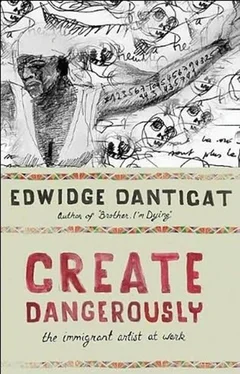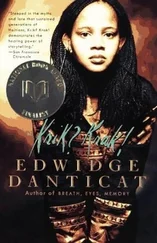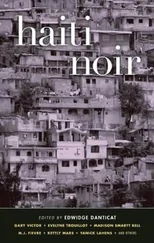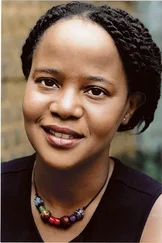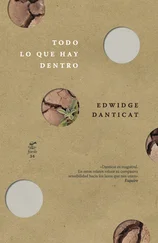One of the many ways a sculptor of ancient Egypt was described was as “one who keeps things alive.” Before pictures were drawn and amulets were carved for ancient Egyptians tombs, wealthy men and women had their slaves buried with them to keep them company in the next life. The artists who came up with these other types of memorial art, the art that could replace the dead bodies, may also have wanted to save lives. In the face of both external and internal destruction, we are still trying to create as dangerously as they, as though each piece of art were a stand-in for a life, a soul, a future. As the ancient Egyptian sculptors may have suspected, and as Marcel Numa and Louis Drouin surely must have believed, we have no other choice.
Walk Straight
I am not going to make it all the way, I think. We’ve been walking for four hours and suddenly I have a piercing pain in my side. My cousin Maxo’s oldest son, Nick, is about thirty feet ahead, hiking at a steady gait, following my Uncle Joseph, who’s been struggling up a steep mound on a borrowed mule. We have been told that the mule knows the way, instinctively, has made the journey several times before, but I haven’t, not for a while, not since I was eight years old.
Short and stout and handsome, Nick stops and pulls a pack of menthol Comme Il Faut cigarettes out of his shirt pocket. While lighting up, he turns around to check on me, doubled over, hugging my midsection, where the pain has spread from my abdomen down to my thighs. Nick walks over and puts his nonsmoky hand on my shoulder.
“Tired?” he asks.
I want to tell him that I am more than tired, but I am saving all my strength to ward off the pain.
“I think I’m dying,” I finally manage to say.
“No you’re not,” he answers, chuckling before drawing once more on his cigarette. “I was just like you when I came back here for the first time in a while. All the walking is just catching up with your body. You’ll be fine in a minute.”
We stop to rest on a slick rock facing a lime-colored mountain range and take cover from the scorching midday sun under a small almond tree. Just as Nick predicted, my pain slowly subsides while he finishes his cigarette. We watch as my uncle and the mule slowly descend through a rift in the mountainside, toward our ancestral village, Beauséjour, where my paternal great-grandparents are buried and where my seventy-five-year-old Aunt Ilyana still lives.
It is the summer of 1999 and I have come to revisit these mountains from which our family has sprung and which have released us to different types of migrations. I have come to see just how far we have trekked in less than two generations, from Léogâne’s rural hamlet of Beauséjour to Miami and New York City, from the valley to skyscrapers. I have come to see an aunt whom I have seen only once before in my life, when I was eight years old, because she has literally refused to come down from the mountain.
After a brief rest, I reclaim my mountain legs and continue on. Along the way, Nick and I retell each other fragmented stories about my great-grandparents-his great-great-grandparents-the furthest that memory and history go back in our family, vague tales that we’ve gathered from older family members. Like Tante Ilyana, both my great-grandparents lived in Beauséjour their entire lives, never venturing farther than Dabonne, the first big market town off the mountain. When they married, together they owned twenty or so acres of land and thirty pigs. Of the twelve children to whom my great-grandmother gave birth, only four made it to adulthood. My great-grandparents spent their whole lives without electricity, telephones, medical doctors, or morgues. When their children died at varying ages in childhood, they buried them the same day or the next, for lack of said morgue.
As we cross an arch of rock that forms a slanted bridge on the side of the mountain, Nick and I lament the fact that there is not more to say of our progenitors’ lives beyond these indefinite segments, which could be true of almost anyone else who had lived here in these mountains.
As children, Nick and I had both come here, along with my brother Bob, to spend a week with Tante Ilyana, who is the last close family member still living in Beauséjour. Everyone else, including my grandparents, had migrated, some to the Haitian capital and others to other parts of the world. I don’t remember the childhood climb up the mountain being so grueling. I remember skipping over what seemed like molehills then, compared to this endless series of cliffs and crags. I remember collecting dandelions as we passed the gardens of people who had known our fathers and grandfathers when they were our age, people who called us by the names of our aunts and uncles, people of whom there is no longer any trace. I remember plucking handfuls of vetiver and citronella, crushing them in my hand to inhale their fragrance. I don’t remember the domes of bare rock. I don’t remember my Aunt Ilyana’s house looking so isolated from up high. I don’t remember the pain in my calves, the agony of every step.
When I say this to Nick, he replies, “Perhaps it’s because you were lighter, because you were a little girl.”
We meet up with Uncle Joseph on the descent toward Tante Ilyana’s house as he stops for a rest of his own. He offers the borrowed mule to Nick, who barely escapes a kick in the groin as he tries to mount the animal.
“This is why I have never been on one of those,” I say.
“You’ve just never been tired enough,” replies Uncle Joseph, who, at seventy-six years old, has been coming to Beauséjour from the capital a couple of times a year to visit Tante Ilyana and see after a small school that he has started here.
Uncle Joseph points out the one-room schoolhouse down below. It looks tiny and lopsided, no different from the small cemetery behind it, the cluster of marble-looking tombs where my great-grandparents are buried.
We reach Tante Ilyana’s house by midafternoon. It is a modest two-room home made of limestone walls and a tin roof. The house stands between a stream and a banana grove and has not changed very much since Nick, Bob, and I came here as children, except that the tin roof has been replaced a couple of times due to rust and hurricanes. Tante Ilyana lives alone now, but her ex-husband has his own place nearby and he visits often, as does her adult son, my cousin Renel, who is a dentist in Port-au-Prince. Unlike my father, his brothers and sisters, and Renel, who followed one another to the city, Tante Ilyana remained behind with her daughter, Jeanne, until, the year before our visit, Jeanne died at the age of thirty-eight, of some unnamed deadly infectious disease passed on to her by a philandering former husband. After Jeanne’s death, Tante Ilyana had entombed her oldest child and only daughter in a beautiful turquoise three-tiered mausoleum next to the house. In Jeanne’s mausoleum a place is reserved for Tante Ilyana, so mother and daughter can be together again in death as they had always been in life.
Tante Ilyana is not home when we arrive. Her grandsons, Jeanne’s two teenage boys, who are visiting from the capital for the summer, give us some water and a large sisal mat to collapse on as we wait for her to return. We immediately crash on the front porch, in a cool spot close to the wooden railing at the other end of which the boys are pouring dried corn kernels into a grinder, turning them into bright yellow cornmeal. The boys are surrounded by twelve of Tante Ilyana’s prized hens and roosters, which squawk loudly as handfuls of corn occasionally rain down on their heads.
Tante Ilyana arrives an hour or so later. She looks much younger than her seventy-five years. Her skin is an even mahogany hue and her body looks taut and lean, almost muscular. She is wearing a dark green dress and a black head wrap. She kisses Uncle Joseph and Cousin Nick hello, but, having not seen me in more than twenty-two years, does not recognize me. She lists the names of a few of my girl cousins, trying to guess who I am. Finally Uncle Joseph says, “It’s Mira’s daughter, Edwidge.”
Читать дальше
